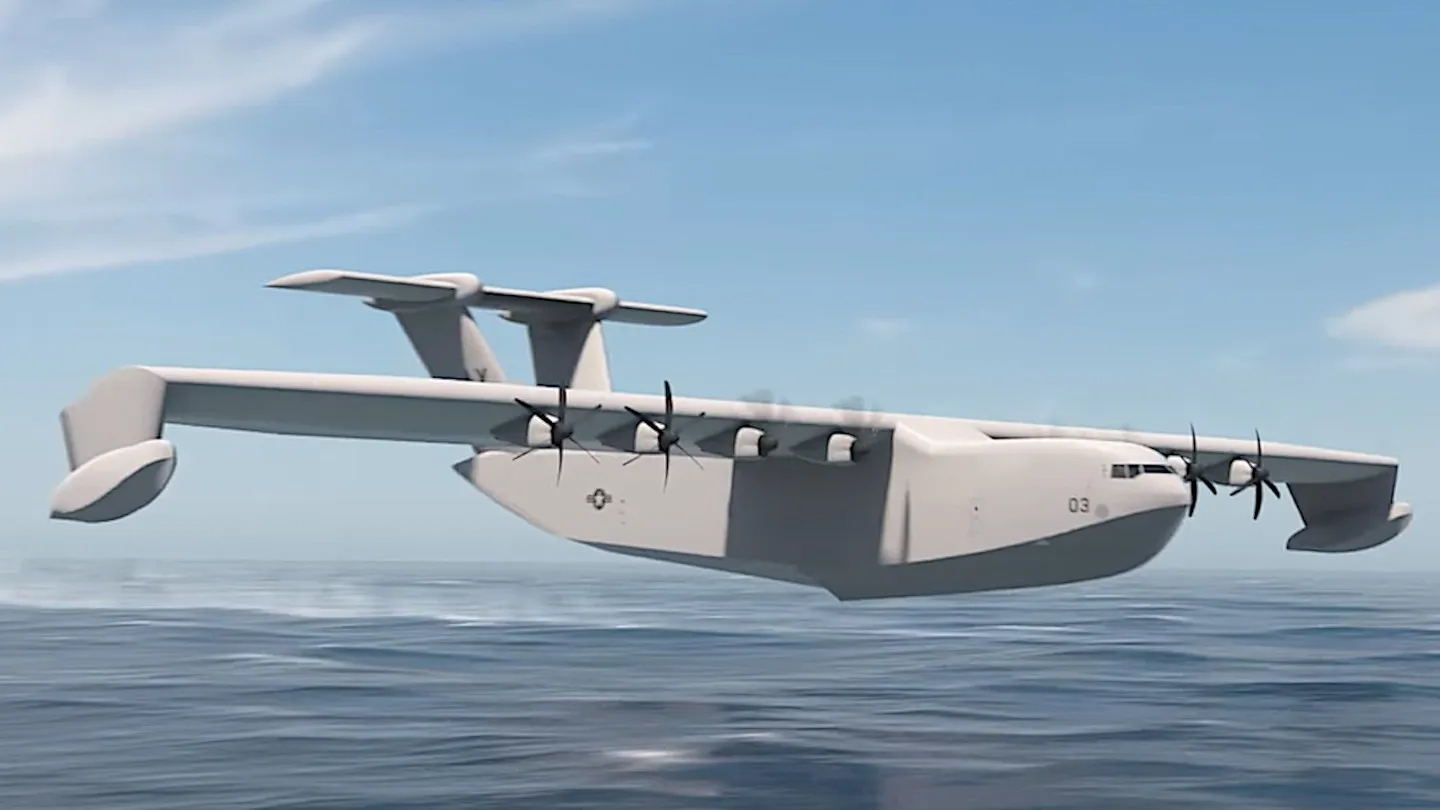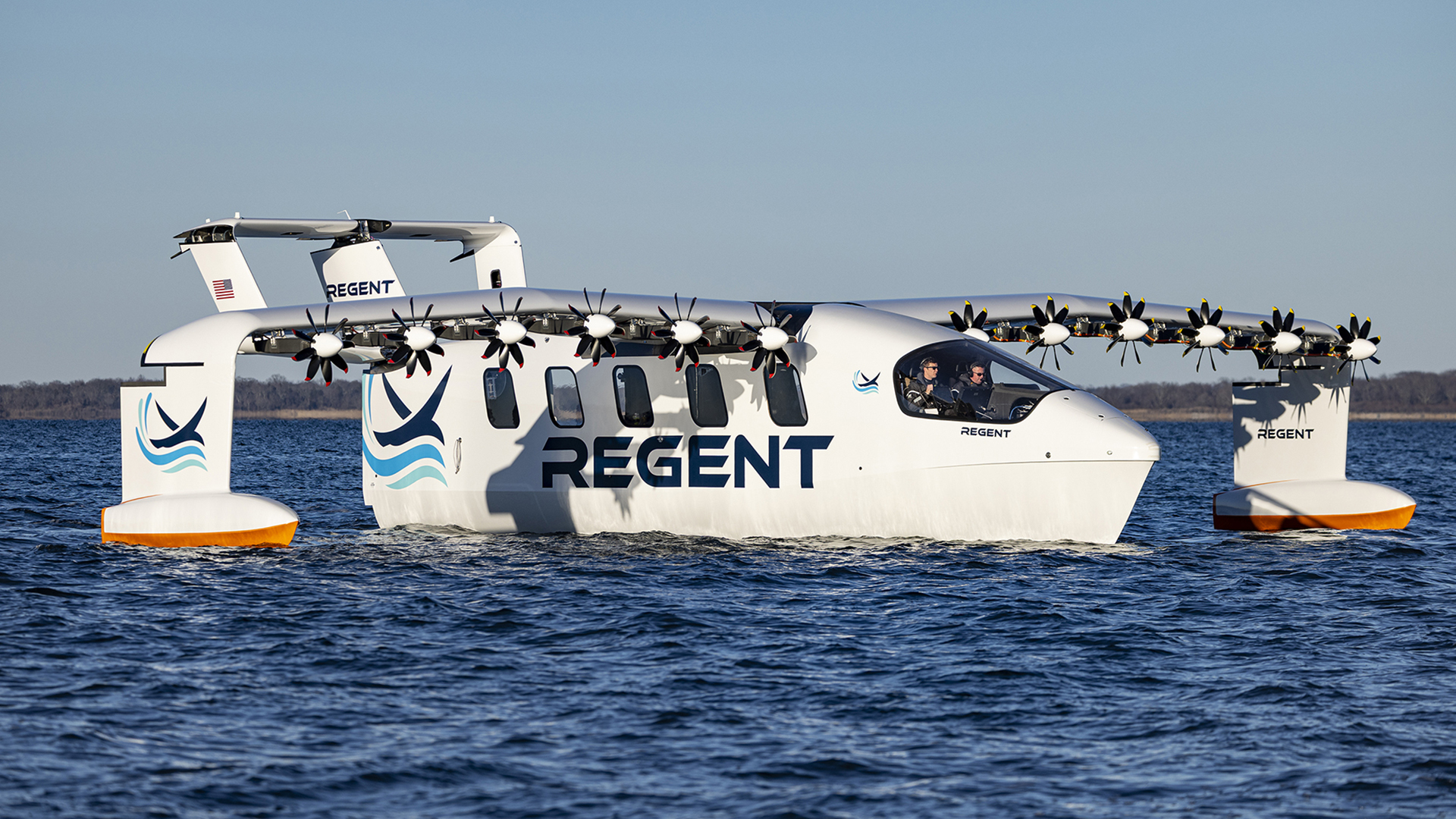As the Marines prepare for future fights in the Pacific, they are investigating the use of the Viceroy Seaglider to quickly and quietly deliver troops and cargo and provide other critical functions. Under development by the Rhode Island-based REGENT company, the craft will be powered by 12 electric motors and runs on batteries. It is designed to carry 12 passengers or 3,500 pounds of cargo, all while swiftly skimming the surface of the ocean, allowing it to avoid enemy sensors. It uses a hydrofoil to get airborne and then can cruise efficiently in ground effect over the water. Since it will operate without the need for a runway, it will be able to access remote locales with little infrastructure.
“We’re primarily looking at it for our contested logistics,” Matthew Koch, a project manager for the Marine Corps Warfighting Laboratory (MCWL), told us from the showroom floor at the Modern Day Marine symposium in Washington D.C. “There is a gap right now for high speed transport, and this fits this gap.”

This craft is also envisioned to perform reconnaissance, infil, exfil, special operations missions, casualty and medical evacuations, and “replace sorties and UH-1 helicopter runs. And that’s just the start of what we can see there,” Koch added.
Koch, whose unit is a division of the Marine Corps’ Combat Development & Integration (CD&I) Command, is tasked with advising leadership on capabilities to help inform future requirements.
The Viceroy offers several advantages, he explained.

The fact that it is a dual-use technology already of high-interest from airlines and ferry companies is key, he noted to us. Tom Huntley, REGENT’s VP of Government Relations and Defense, told us Viceroy will enter into commercial service in 2027.
“By leveraging the commercial technology, we’re getting something that’s significantly affordable,” Koch stated, adding that it avoids the lengthy process of presenting capabilities needs to industry and waiting for a solution.
“We are leveraging what’s currently available in the military or in the commercial world for military applications and modifying it as needed,” he said. “Right now, we’re looking at a price point between $5 million and $7 million a copy. It provides us the high-speed, low-signature transport at a cost-effective price point.”
The Viceroy, a hydrofoiling wing-in-ground (WIG) effect craft, “is currently in sea trials,” REGENT Mission Assurance Manager Kristin Pedersen told us.



The WIG design allows a craft to move efficiently at higher speeds because it does not suffer from the drag associated with typical ship designs, while also benefiting from the lift generated by a wing.
“Our Seaglider goes through three phases of transportation — float, foil and fly, and our sea trials will mirror that as a progressive step,” Pedersen told us. “So we’re currently in the float stage of that three-phase approach for sea trials.”
The Viceroy is scheduled to undergo testing on its hydrofoil capabilities in the early summer and flight testing by the end of the summer, she added.
As we have previously noted, the WIG concept certainly is not new, but prior attempts to employ it on a large scale have generated limited success, particularly for military purposes.
From our prior reporting: “The Soviet Union remains the most notable operator of military WIG designs, known in Russian as ekranoplans – a term now widely used as a catch-all for WIG designs – but even there their service was limited. Efforts to revive military ekranoplans in Russia in recent years have so far not produced any operational types.”
The video below shows the only Project 903 Lun class ekranoplan, a cruise missile-armed design, that the Soviet Union ever completed being moved in the Caspian Sea in 2020 as part of a plan to put it on display.

High-speed sea-skimming flight presents challenges, including the risk of collisions with various objects on the surface or even just high cresting waves. Koch, the MCWL project manager, said Viceroy’s hydrofoil addresses some of those concerns.
“The hydrofoil is actually one of the key technologies to help the Seaglider come to life,” he explained. “Typical seaplanes or wing-in-ground craft in the past have had limitations due to how much they can take on the sea state. By operating on the actively controlled hydrofoils, it brings the craft out of the water and reduces the amount of craft that’s being surfaced with water.”
“The hydrofoils allow us to be five feet above the waves,” Pedersen offered. “You’re operating outside of the water, so you’re not as susceptible to those waves to be able to smoothly transition into that flight mode.”
In addition, “the Seaglider uses numerous sensor systems to provide a blended solution to the operators, enhancing situational awareness and providing hazard identification,” REGENT spokesperson Kirsten Salyer told us. “The triple redundant automated vehicle control system enables captains to navigate left/right and fast/slow control inputs.”

Once the hydrofoils are deployed, the Viceroy is designed to go from floating at 12 knots to speeding up to 45 knots and then taking off, operating in ground effect mode, Koch posited. Once airborne, it reaches speeds up to 180 knots. It can take off in Sea State of 3-plus and land in Sea State 5, Pedersen added. These two Sea States are characterized by wind speeds of 7 to 10 knots and 17 to 21 knots, as well as wave heights between two and three feet, and five and eight feet, respectively.
The Viceroy design offers another advantage, Koch stated
It has “very interesting signature properties,” he said.
Because it is not a vessel, it operates with far less wake, which can make a ship more visible to adversary sensors. The electric motors reduce its heat signature. In addition, the Viceroy is designed to fly at about 30 feet above the surface, allowing it to fly under radar coverage and above sonar coverage, according to the company.

Under its current configuration, the Viceroy has a range of about 180 miles. Future iterations with hybrid-electrical powerplants arrangement could enable it to travel nearly 1,000 miles. The aircraft is designed to be transportable by large cargo aircraft, like the C-17, and it can recharge from really any electrical power source, which opens up fuel independent operations. This could be of a big advantage in the Pacific where fuel distribution will be under pressure.
The U.S. Coast Guard has approved REGENT’s Navigational Safety Risk Assessment for the prototype, which allows REGENT to test with humans on board in Narragansett Bay and Rhode Island Sound, the company stated. REGENT has also submitted its Viceroy Design Basis Agreement with the U.S. Coast Guard.
The Seaglider concept is one of several WIG craft that the U.S. military is considering to solve the problems of delivering troops and cargo quickly over vast bodies of water, while limiting their vulnerability to enemy weapon systems.
As we noted earlier in the week, the Defense Advanced Research Projects Agency (DARPA) has the Liberty Lifter X-plane program. Its core goal is to produce a flying transport design that employs the WIG effect principle. You can read more about that program in our story here.

So far, the Marines have made a low-cost bet on this concept. In March, REGENT was awarded a $10 million contract to allow it “to demonstrate their full-size prototypes and multiple military demonstrations, which we will use to help inform future requirements,” Koch said. That follows a $4.75 million contract signed in 2023 to demonstrate the technological feasibility of Viceroy.
There is still a long way to go before this craft joins the Marine arsenal, if it does at all. The fact that MCWL has invested time and money into the concept, though, shows there’s a real interest in it.
Contact the author: howard@thewarzone.com
